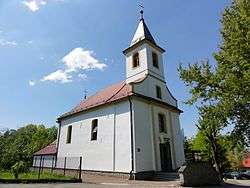Lipowiec, Ustroń
| Lipowiec | |
|---|---|
| Osiedle of Ustroń | |
|
Exaltation of the Holy Cross Church | |
| Coordinates: 49°44′55.7″N 18°49′58.9″E / 49.748806°N 18.833028°ECoordinates: 49°44′55.7″N 18°49′58.9″E / 49.748806°N 18.833028°E | |
| Country |
|
| Voivodeship | Silesian |
| County | Cieszyn |
| Time zone | CET (UTC+1) |
| • Summer (DST) | CEST (UTC+2) |
| Area code(s) | (+48) 033 |
Lipowiec is a district (osiedle) of Ustroń, Silesian Voivodeship, Poland. It was a separate municipality, but became administratively a part of Ustroń on January 1, 1973.[1]
History
The village was first mentioned in a Latin document of Diocese of Wrocław called Liber fundationis episcopatus Vratislaviensis from around 1305 as item in Lypowetz.[2][3][4] It meant that the village was in the process of location (the size of land to pay a tithe from was not yet precised). The creation of the village was a part of a larger settlement campaign taking place in the late 13th century on the territory of what will be later known as Upper Silesia.
Politically the village belonged initially to the Duchy of Teschen, formed in 1290 in the process of feudal fragmentation of Poland and was ruled by a local branch of Piast dynasty. In 1327 the duchy became a fee of the Kingdom of Bohemia, which after 1526 became part of the Habsburg Monarchy.
The village became a seat of a Catholic parish, first mentioned in an incomplete register of Peter's Pence payment from 1335 as Lipovecz[5] and as such being one of the oldest in the region. However local parish quickly ceased to exist and was not mentioned among local parishes in 1447.[6]
In years 1573/1577–1594 it belonged to Skoczów-Strumień state country that was split from the Duchy of Teschen but was later purchased back.[7] Since 1653 it belonged to Teschener Kammer.
After Revolutions of 1848 in the Austrian Empire a modern municipal division was introduced in the re-established Austrian Silesia. The village as a municipality was subscribed to the political district of Bielsko and the legal district of Skoczów. According to the censuses conducted in 1880, 1890, 1900 and 1910 the population of the municipality grew from 936 in 1880 to 961 in 1910, with majority of the inhabitants being native Polish-speakers (98.5%-99.9%) and a small German-speaking minority (most 12 or 1.3% in 1880) and at most two people Czech-speaking (in 1880 and 1890), in terms of religion majority were Roman Catholics (88.2% in 1910), followed by Protestants (11.6% in 1910) and Jews (2 people).[8] The village was also traditionally inhabited by Cieszyn Vlachs, speaking Cieszyn Silesian dialect.
After World War I, fall of Austria-Hungary, Polish–Czechoslovak War and the division of Cieszyn Silesia in 1920, it became a part of Poland. It was then annexed by Nazi Germany at the beginning of World War II. After the war it was restored to Poland.
References
- ↑ Rozporządzenie Prezesa Rady Ministrów z dnia 30 listopada 1972 r. w sprawie utworzenia, zniesienia i zmiany granic niektórych miast., Dz. U. z 1972 r. Nr 50, poz. 327
- ↑ Panic, Idzi (2010). Śląsk Cieszyński w średniowieczu (do 1528) [Cieszyn Silesia in the Middle Ages (until 1528)] (in Polish). Cieszyn: Starostwo Powiatowe w Cieszynie. p. 297-299. ISBN 978-83-926929-3-5.
- ↑ Schulte, Wilhelm (1889). Codex Diplomaticus Silesiae T.14 Liber Fundationis Episcopatus Vratislaviensis (in German). Breslau.
- ↑ "Liber fundationis episcopatus Vratislaviensis" (in Latin). Retrieved 13 July 2014.
- ↑ Ptaśnik, Jan (1913). Monumenta Poloniae Vaticana T.1 Acta Camerae Apostolicae. Vol. 1, 1207-1344. Cracoviae: Sumpt. Academiae Litterarum Cracoviensis. p. 366.
- ↑ "Registrum denarii sancti Petri in archidiaconatu Opoliensi sub anno domini MCCCCXLVII per dominum Nicolaum Wolff decretorum doctorem, archidiaconum Opoliensem, ex commissione reverendi in Christo patris ac domini Conradi episcopi Wratislaviensis, sedis apostolice collectoris, collecti". Zeitschrift des Vereins für Geschichte und Alterthum Schlesiens (in German). Breslau: H. Markgraf. 27: 361–372. 1893. Retrieved 21 July 2014.
- ↑ Panic, Idzi (2011). Śląsk Cieszyński w początkach czasów nowożytnych (1528-1653) [Cieszyn Silesia in the beginnings of Modern Era (1528-1653)] (in Polish). Cieszyn: Starostwo Powiatowe w Cieszynie. pp. 68, 228. ISBN 978-83-926929-5-9.
- ↑ Piątkowski, Kazimierz (1918). Stosunki narodowościowe w Księstwie Cieszyńskiem (in Polish). Cieszyn: Macierz Szkolna Księstwa Cieszyńskiego. p. 260, 278.
| Wikimedia Commons has media related to Lipowiec (district of Ustroń). |
